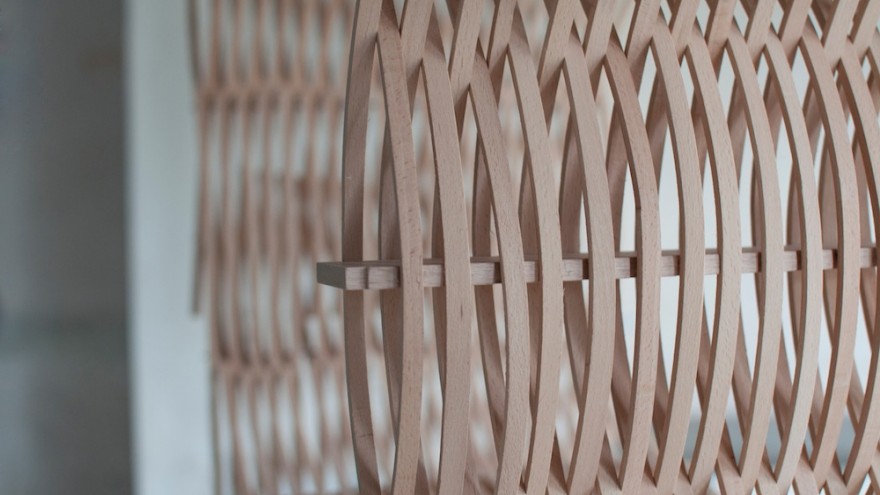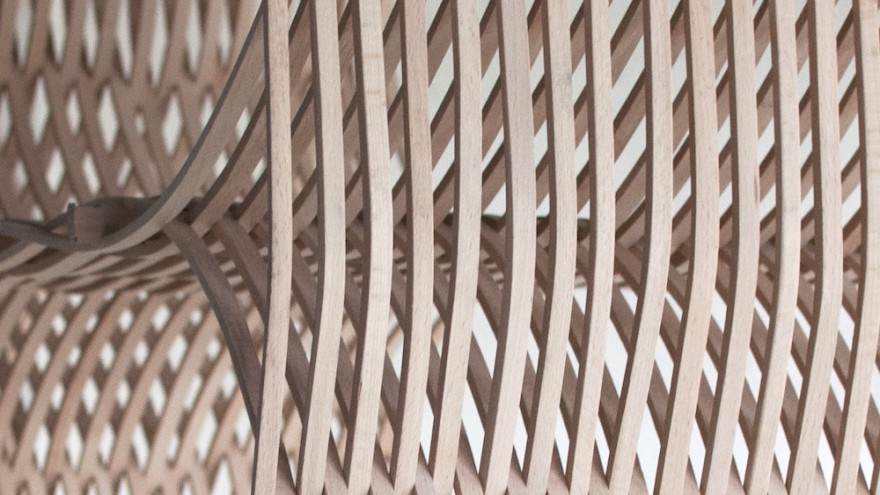“Objects can have the power to capture the viewer’s focus by intriguing and mesmerising their senses,” says Martina Lasinger. Her graduate projects from her final year at Design Academy Eindhoven do just that: her exceptional Wovet storage piece and her four-part N-O-W series beg to be looked at.
In Wovet, Lasinger has combined traditional basket weaving with Bendywood, a curved wood product that doesn’t need the application of heat, to create a piece of furniture that is sculptural, functional and iconoclastic. The resulting product, which can function as display or storage, is held together purely by structural tension – no glue, nails or screws. It’s woven permeable surfaces combine sinuous curves with implied geometric shapes for a design that is the antithesis of traditional rigid carpentry.
The individual pieces of beech wood in Wovet have been applied in a way that carries the gaze in different directions. Lasinger notes that the design plays with light and perception.
As you walk by, the cabinet almost seems to vibrate through an intriguing moiré effect, she says.
Her second graduation project is a series of “meditative objects” designed to be contemplated. “Their interactive and self-dynamic appearance causes a deep observation within the viewer,” Lasinger notes. “The gaze will be caught and the mind will be mesmerised through the poetics of the object.”
With a piece to represent each of the four elements – earth, wind, fire, water – Lasinger’s designs correspond to the Zen principle of the impermanence of all things. For instance, in N-O-W, which expresses the element of earth, the concept of a traditional Zen garden meets the mechanised motion of a clock. As lines are drawn in the sand, they are erased by the same mechanism, demonstrating the eternal flux between being and void.
Similarly, the other elements – W-A-V-E (water), Z-U-N (fire) and I-N-C-E-N (air) – all demonstrate balance and cyclical change in different ways. Lasinger says that researching the meaning and practices of various religions and philosophies led her to a visualisation of rituals, which refer to various religions but are not tied to any particular one.
Lasinger was born in the remote countryside of Austria and developed a relationship with materials and making at an early age by observing her grandfather, a traditional blacksmith. She remembers watching timber getting cut and stacked to dry with curiousity, as well as building a fence at the tender age of five.
Describing her youth and early education, she says “I already knew that I had abilities in applied arts and geometrical drawing. Gymnastics and art have always been my talents. However, sport stayed a leisure activity; and art and design became my profession.”
In most of her designs, she makes everything herself, with the resulting product being completely hand-crafted. “I am aiming for perfection in form, visualising philosophies and craftsmanship in a tactile way, while being a source of inspiration for others.”









